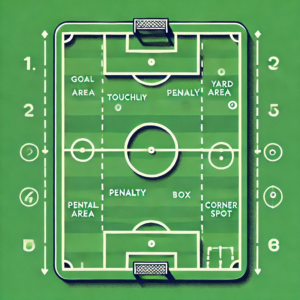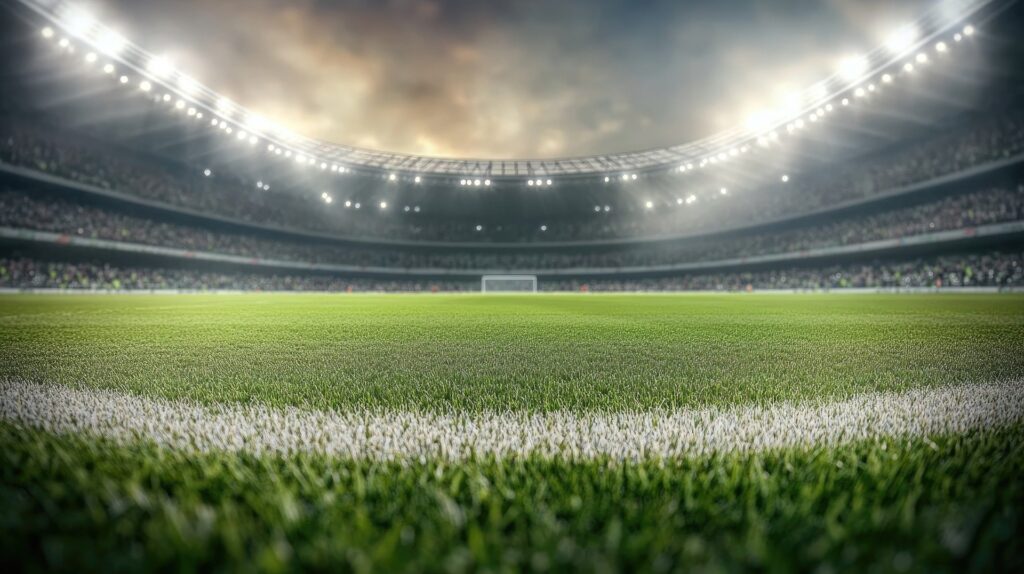
Football is an activity that requires massive rules and regulations in the game to have a fair play. One of the aspects of the game is the marks made on the ground, which often guide the players and sometimes the referees during a match at times. At some points, these lines might not be seen by the spectators as they are being painted in curves and circles all over the playing field. These marks are very important in clearly stipulating the playing area, the positioning of the players, and ensuring the game goes on without hindrances.
We will identify all markings present on the football ground, the reason behind every marking, and how all these markings will affect the game in this article.
1. The Touchlines
The two longer boundary lines present along the length of the football field are called the touchlines. These lines define the outer limits of the field on both sides.
Length: 90 to 120 meters (100 to 130 yards)
The ball shall be out of play if it totally crosses the touchline, on or off the ground. A throw-in shall be awarded to the opposing team if a player last touches the ball before it crosses the line. Touchlines also take up parts of defining the field on which the game is played while affecting some players’ positioning for some plays-the most noticeable examples being throw-ins.
2. Goal Lines
The narrower boundary lines, at either end, are termed as the goal lines and run between the two goalposts. As has been pointed out above, whereas the touchlines delimit the playing area in terms of length, the goal lines delimit the playing area in terms of width.
Width: 45 to 90 meters or 50 to 100 yards
A goal has been scored if the whole circumference of the ball entirely passes through the goal line. It, thereby enters between the goal posts and under the crossbar. There are two scenarios wherein the ball passes on the outer side of the goal post to pass through the goal line. These are a goal kick and a corner kick, depending whose feet last touched the playing ball.
Goal Lines The goal lines play a crucial role in determining whether or not a goal is scored and when goal kicks or corner kicks are taken.
3. Goal Area: (6-Yard Box)
The goal area is also called the “6-yard box”. It is a rectangular area in front of both goals. The box plays an important role in many aspects of the game, though particularly for the goalkeeper.
Dimensions:
Width: 18.32 meters (20 yards)
Distance from the goal line: 5.5 meters (6 yards)
The goal area is any part of the goal area. It gives the referees reference when, on goal kicks and some other restarts, to make sure the ball is placed correctly.
The penalty area, also known as the 18-yard box, protects the goalkeeper’s space, giving the goalkeeper a marked area by which he or she can distribute the ballest when taking a goal kick.
4. The Penalty Area (18-Yard Box)
The area known as the “18-yard box” is technically the penalty area, the most important space on a football field. It runs forward from the goal line and consists both of the goal area, plus that elementary area of activity of the goalkeeper.
Size:
Width: 40.3 metres (44 yards)
Depth: 16.5 meters (18 yards) from the goal line.
This region states the area in which the keeper is entitled to touch the ball. Fouls committed by the defending party in this area attracts a penalty kick for the attacking team.
Fouls in the penalty area become infinitely more serious and often lead to a penalty kick that can easily give way to a goal.
5. The Pen Spot
The penalty area and within it is the area called the pen spot. It is a region in which penalty kicks are taken.
Distance: 11 meters (12 yards) from the goal line
Penalty kicks, awarded for fouls inside the penalty area, are taken from this spot. When a penalty is awarded, the ball is placed on the penalty spot, and the attacking player must shoot from this location with only the goalkeeper allowed to defend.
6. The Center Circle
The center circle forms a midway boundary of the football pitch, which falls immediately around the center mark where kick-offs are taken.
Radius: 9.15 meters, 10 yards
During the kicking off at the start of the play or after a goal, only the members of the kicking team are allowed inside the center circle; other members of the opposite teams are to stand outside the said circle until the ball is kicked.
This circle ensures that the defense team does not congest the players taking the kickoff, thus leaving them open to start playing.
7. Halfway Line
The halfway line divides the football pitch into two equal parts.
It refers to a line by which teams are split at kick off. It also determines offside points as any player who is in the opponent half more than he is behind the centerline, an offside would be called. The line of demarcation between the two halves of the field through the halfway line will determine clearly where the team starts.
8. The Corner Arc
There exists a small quarter-circle at every corner of the football field, and it is termed as the corner arc.
Radius: 1 meter (1 yard)
A corner arc is the area where the ball must be located at the time of a corner kick. A corner arc serves as a particular location from which a corner kick must be taken to prevent attacking teams from placing the ball too far from the corner, earning them an unfair advantage.
9. The Goalposts and Crossbar
Even though not strictly on the ground, the goal posts and crossbar make up an essential component of the field.
Measurements:
Width: 7.32 meters (8 yards)
Height: 2.44 meters (8 feet) from the ground
The ball is considered to be a goal if it passes through between the goalposts and under the crossbar. The goal posts and crossbar, forming the physical body of the goal structure, determine whether the ball is in or out.
10. Substitution Areas
Substitution areas do not have to be indicated on amateur pitches, although they are usually located just about the middle of a field, either along the sideline outside the field of play.
Substitution areas inform the match officials, coaches, and players where exactly the team can enter and leave the field as part of making substitutions.
11. Technical Area
Technically, this area falls outside the playing field where it is permissible for the coaches to stand and give instructions.
It restrains movement of both the coaches and the staff in such a way that they are not interfering with the game. Marking of this area ensures that the coaches can guide without obstructing the play or straying too close to the field.
How Technical Area Markings Affect the Game
Football ground markings bear a strong influence on the course of the game if they are clear and visibly accurate. Clearly and properly measured lines:
1. Enable the referee clearly determine the offside calls, foul, and goals.
2. Enable players to maintain correct positions to prevent fouls and execute set plays.
3. Make it easier for spectators and commentators to understand the flow of the game; thus, making the event better.
On the other hand, bad markings may lead to muddled confusion, uneven chances, and controversial referee decisions that mar the match.
Football ground markings are synonymous with the game. They determine and direct the motion of players within the ground, how goals come about, and how the referees aim at maintaining or enforcing their rules. From the touchline to the penalty area, each line and arc of the field has been thoughtfully assigned a specific place in order to ensure that the game rolls on smoothly. Without these lines and marks, the structure, strategy, and excitement of football would all take a terrible hit. So the next time you watch a football match, take some time and understand how these markings come together to make the world’s most popular sport.


